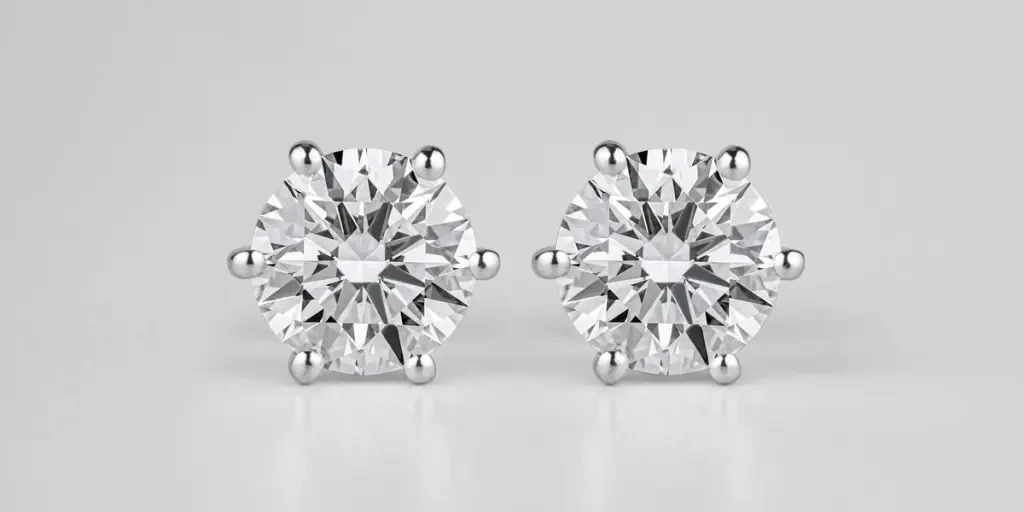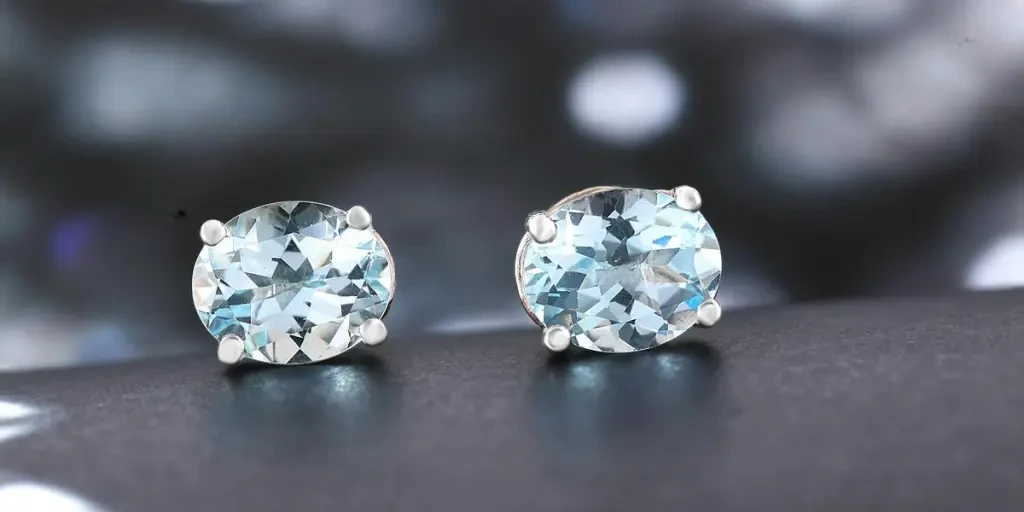Im Labor gezüchtete Diamantohrringe revolutionieren die Schmuckindustrie und bieten eine nachhaltige und erschwingliche Alternative zu natürlichen Diamanten. Da sich die Verbraucherpräferenzen in Richtung ethischer und umweltfreundlicher Produkte verschieben, werden im Labor gezüchtete Diamanten aufgrund ihrer identischen physikalischen und chemischen Eigenschaften mit natürlichen Diamanten immer beliebter. Dieser Artikel befasst sich mit den Markttrends, Wachstumstreibern und Zukunftsaussichten von im Labor gezüchteten Diamantohrringen.
Table of Contents:
-Marktübersicht: Der Aufstieg der im Labor gezüchteten Diamantohrringe
-Innovative Designs und Stile bei im Labor gezüchteten Diamantohrringen
-Die neuesten Designtrends entdecken
-Der Einfluss von Schnitt und Farbe auf die Attraktivität
-Materialqualität und Haltbarkeit
- Die Zusammensetzung von im Labor gezüchteten Diamanten verstehen
-Vergleich von im Labor gezüchteten Diamanten mit natürlichen Diamanten
-Kultureller Einfluss und Erbe
-Die wachsende Akzeptanz von im Labor gezüchteten Diamanten in verschiedenen Kulturen
-Wie das Erbe moderne Schmucktrends prägt
-Abschluss
Marktübersicht: Der Aufstieg der im Labor gezüchteten Diamantohrringe

Der globale Markt für Diamantschmuck verzeichnet ein starkes Wachstum, wobei im Labor gezüchtete Diamanten bei dieser Expansion eine entscheidende Rolle spielen. Laut Research and Markets wuchs der Markt für Diamantschmuck von 405.60 Milliarden USD im Jahr 2023 auf 426.50 Milliarden USD im Jahr 2024 und wird voraussichtlich mit einer durchschnittlichen jährlichen Wachstumsrate von 5.34 % weiter wachsen und bis 583.83 2030 Milliarden USD erreichen. Dieses Wachstum wird durch steigende verfügbare Einkommen, insbesondere in Schwellenländern, und die zunehmende Beliebtheit von im Labor gezüchteten Diamanten vorangetrieben.
Im Labor gezüchtete Diamanten, auch als synthetische Diamanten bekannt, werden mithilfe hochentwickelter technologischer Verfahren hergestellt, die die natürliche Diamantbildung nachbilden. Diese Diamanten sind chemisch, physikalisch und optisch identisch mit natürlichen Diamanten, was sie zu einer attraktiven Option für Verbraucher macht, die hochwertigen Schmuck zu einem niedrigeren Preis suchen. Die Erschwinglichkeit und Nachhaltigkeit von im Labor gezüchteten Diamanten sind Schlüsselfaktoren, die zu ihrer steigenden Nachfrage beitragen.
Der Markt für im Labor gezüchtete Diamantohrringe wächst rasant, da sich die Verbraucher der ethischen und ökologischen Vorteile von im Labor gezüchteten Diamanten gegenüber natürlichen Diamanten immer mehr bewusst werden. Die Produktion von im Labor gezüchteten Diamanten macht den Bergbau überflüssig, reduziert die Umweltbelastung und berücksichtigt ethische Bedenken im Zusammenhang mit der Diamantenbeschaffung. Dieser Wandel hin zu nachhaltigen Praktiken findet bei umweltbewussten Verbrauchern Anklang und treibt das Marktwachstum weiter voran.
Regionale Einblicke zeigen, dass Amerika, insbesondere die Vereinigten Staaten, bei der Einführung von im Labor gezüchteten Diamanten führend sind. Die hohe Kaufkraft der Verbraucher und die gut etablierten Einzelhandelsumgebungen in der Region fördern das Wachstum von Schmuck aus im Labor gezüchteten Diamanten. In Europa ist der Markt durch eine Vorliebe für Premiummarken und traditionelle Handwerkskunst gekennzeichnet, wobei Nachhaltigkeit und ethische Beschaffung zunehmend im Vordergrund stehen. Auch die Region Asien-Pazifik erlebt ein signifikantes Wachstum, das von einer wachsenden Mittelschicht und einem kulturell verankerten Markt für Diamantschmuck angetrieben wird.
Zu den wichtigsten Akteuren auf dem Markt für im Labor gezüchtete Diamanten zählen House of Heere, Aukera Grown Diamond Jewellery und KISNA Diamond and Gold Jewellery. House of Heere hat eine nachhaltige Schmucklinie aus im Labor gezüchteten Diamanten auf den Markt gebracht, bei der Qualität und ethische Beschaffung im Vordergrund stehen. Aukera Grown Diamond Jewellery stellte seine „Queen's Reserve Polki Collection“ vor, die im Labor gezüchtete Polki-Diamanten umfasst und damit der steigenden Nachfrage nach ethischen Luxusprodukten entspricht. KISNA Diamond and Gold Jewellery erweiterte seine Einzelhandelspräsenz mit einem neuen Franchise-Showroom, in dem eine breite Palette von im Labor gezüchteten Diamantschmuckstücken präsentiert wird.
Zukünftige Trends auf dem Markt für im Labor gezüchtete Diamanten deuten auf einen anhaltenden Fokus auf Innovation und Nachhaltigkeit hin. Technologische Fortschritte wie Augmented-Reality-Shopping-Erlebnisse und Initiativen zum Recycling von Diamanten werden voraussichtlich das zukünftige Marktwachstum vorantreiben. Die Expansion von E-Commerce-Plattformen und die zunehmende Beliebtheit von im Labor gezüchteten Diamanten bieten Marktteilnehmern erhebliche Möglichkeiten, von der wachsenden Nachfrage nach nachhaltigem und erschwinglichem Diamantschmuck zu profitieren.
Innovative Designs und Stile bei im Labor gezüchteten Diamantohrringen

Entdecken Sie die neuesten Designtrends
Ohrringe aus im Labor gezüchteten Diamanten sind zu einem bedeutenden Trend in der Schmuckbranche geworden, angetrieben von ihrer ethischen Attraktivität und ihren innovativen Designs. Die neuesten Designtrends bei Ohrringen aus im Labor gezüchteten Diamanten spiegeln eine Mischung aus klassischer Eleganz und moderner Ästhetik wider. Laut einem professionellen Bericht prägt der Trend zu mutigeren Stilen die Kategorie Ohr, wobei Ohrschmuck an Bedeutung gewinnt. Dazu gehört der Ohrstecker, der zu einem festen Bestandteil vieler Kollektionen geworden ist und eine vielseitige und stilvolle Option für verschiedene Anlässe bietet.
Designer experimentieren auch mit Perlen und Tiermotiven, wie man in der „Era Reset“-Kollektion von Paradis Pierre-Louis Mascia sehen kann. Diese Elemente verleihen im Labor gezüchteten Diamantohrringen eine einzigartige und skurrile Note und heben sie auf dem Markt hervor. Darüber hinaus steigert die Einbeziehung von skizzierten Keramiken und auffälligen Blumenmotiven in die Designs ihre Attraktivität noch weiter und verleiht traditionellem Schmuck eine frische und künstlerische Note.
Der Trend zu nuancierten Metallen und vielfarbigem Recyclingmetall ist auch in den neuesten Kollektionen erkennbar. Diese Materialien verleihen den Designs nicht nur eine zeitgenössische Note, sondern entsprechen auch der wachsenden Nachfrage nach nachhaltigem und umweltfreundlichem Schmuck. Die Verwendung von recycelten Metallen und verantwortungsvoll beschafften Perlen, wie im Bericht hervorgehoben, spiegelt ein Engagement für Nachhaltigkeit und ethische Praktiken in der Schmuckindustrie wider.
Der Einfluss von Schnitt und Farbe auf die Attraktivität
Der Schliff und die Farbe von im Labor gezüchteten Diamanten spielen eine entscheidende Rolle für ihre allgemeine Attraktivität. Die Präzision des Schliffs bestimmt die Brillanz und das Funkeln des Diamanten und ist daher ein Schlüsselfaktor beim Design von Ohrringen. Laut Branchenexperten sind die beliebtesten Schliffe für im Labor gezüchtete Diamantohrringe der Rund-, Prinzess- und Kissenschliff, die jeweils ein unverwechselbares Aussehen und ein unverwechselbares Maß an Brillanz bieten.
Die Farbe ist ein weiterer wichtiger Aspekt, der die Attraktivität von im Labor gezüchteten Diamantohrringen beeinflusst. Während traditionelle Diamanten oft wegen ihrer Farblosigkeit geschätzt werden, bieten im Labor gezüchtete Diamanten eine größere Auswahl an Farboptionen. Dazu gehören ausgefallene Farben wie Blau, Rosa und Gelb, die bei Verbrauchern, die einzigartige und personalisierte Schmuckstücke suchen, immer beliebter werden. Die Möglichkeit, Diamanten in verschiedenen Farben durch kontrollierte Laborprozesse herzustellen, ermöglicht es Designern, mit verschiedenen Farbtönen zu experimentieren und atemberaubende, einzigartige Ohrringe zu kreieren.
Materialqualität und Haltbarkeit

Die Zusammensetzung von im Labor gezüchteten Diamanten verstehen
Im Labor gezüchtete Diamanten werden mithilfe hochentwickelter technologischer Verfahren hergestellt, die die natürliche Entstehung von Diamanten nachahmen. Zu diesen Verfahren gehören Hochdruck-Hochtemperatur-Diamanten (HPHT) und chemische Gasphasenabscheidung (CVD), die beide Diamanten mit den gleichen physikalischen, chemischen und optischen Eigenschaften wie natürliche Diamanten erzeugen. Einem professionellen Bericht zufolge ist die Zusammensetzung von im Labor gezüchteten Diamanten praktisch identisch mit der von natürlichen Diamanten, was sie zu einer hervorragenden Alternative für alle macht, die hochwertigen und langlebigen Schmuck suchen.
Die kontrollierte Umgebung, in der im Labor gezüchtete Diamanten hergestellt werden, stellt sicher, dass sie frei von Verunreinigungen und Einschlüssen sind, die häufig in natürlichen Diamanten vorkommen. Dies führt zu Diamanten, die nicht nur optisch atemberaubend, sondern auch erschwinglicher sind, da die Produktionskosten im Vergleich zum Abbau natürlicher Diamanten niedriger sind. Die Fähigkeit, Diamanten mit weniger Unvollkommenheiten und zu geringeren Kosten herzustellen, hat zur wachsenden Beliebtheit von im Labor gezüchteten Diamantohrringen beigetragen.
Vergleich zwischen im Labor gezüchteten Diamanten und natürlichen Diamanten
Beim Vergleich von im Labor gezüchteten Diamanten mit natürlichen Diamanten spielen mehrere Faktoren eine Rolle, darunter Qualität, Kosten und Umweltauswirkungen. Im Labor gezüchtete Diamanten bieten die gleiche Qualität und Haltbarkeit wie natürliche Diamanten, haben aber den zusätzlichen Vorteil, dass sie günstiger sind. Dies macht sie zu einer attraktiven Option für Verbraucher, die hochwertigen Schmuck ohne den hohen Preis natürlicher Diamanten suchen.
In Bezug auf die Umweltauswirkungen haben im Labor gezüchtete Diamanten einen deutlich geringeren CO2-Fußabdruck als natürliche Diamanten. Der Abbau natürlicher Diamanten ist häufig mit umfangreichen Bodenerosionen und dem Einsatz schädlicher Chemikalien verbunden, die sich nachteilig auf die Umwelt auswirken können. Im Labor gezüchtete Diamanten werden dagegen in kontrollierten Laborumgebungen hergestellt, wodurch der Bedarf an Bergbau reduziert und die Umweltschäden minimiert werden. Dies macht im Labor gezüchtete Diamantohrringe zu einer nachhaltigeren und umweltfreundlicheren Wahl für Verbraucher.
Kultureller Einfluss und Erbe

Die wachsende Akzeptanz von im Labor gezüchteten Diamanten in verschiedenen Kulturen
Die Akzeptanz von im Labor gezüchteten Diamanten wächst in verschiedenen Kulturen, was auf ihre ethische Attraktivität und Erschwinglichkeit zurückzuführen ist. In vielen Kulturen werden Diamanten traditionell mit Luxus und Status assoziiert, und im Labor gezüchtete Diamanten werden zunehmend als brauchbare Alternative zu natürlichen Diamanten anerkannt. Einem professionellen Bericht zufolge zeigt sich die wachsende Akzeptanz von im Labor gezüchteten Diamanten darin, dass immer mehr Verbraucher sich beim Kauf von Schmuck für diese Diamanten entscheiden.
In westlichen Kulturen erfreuen sich im Labor gezüchtete Diamanten bei umweltbewussten Verbrauchern, die Wert auf Nachhaltigkeit und ethisches Verhalten legen, zunehmender Beliebtheit. Die Möglichkeit, den Ursprung von im Labor gezüchteten Diamanten zurückzuverfolgen und sicherzustellen, dass sie frei von Konflikten und Ausbeutung sind, ist ein wesentlicher Faktor für ihre Akzeptanz. In östlichen Kulturen, wo Diamanten häufig bei traditionellen Zeremonien und Feiern verwendet werden, werden im Labor gezüchtete Diamanten aufgrund ihrer Erschwinglichkeit und hohen Qualität geschätzt, wodurch sie einem breiteren Publikum zugänglich werden.
Wie das Erbe moderne Schmucktrends prägt
Das Erbe spielt eine entscheidende Rolle bei der Gestaltung moderner Schmucktrends, wobei sich viele Designer von traditionellen Motiven und Techniken inspirieren lassen. Die Einbeziehung von traditionellen Elementen in im Labor gezüchtete Diamantohrringe verleiht den Designs einen Hauch von Geschichte und kultureller Bedeutung. So spiegelt beispielsweise die Verwendung klassischer Kameen und metaklassischer Münzen in Schmuckdesigns, wie Branchenexperten berichten, eine Mischung aus traditioneller und zeitgenössischer Ästhetik wider.
Der Einfluss des Erbes zeigt sich auch in der Verwendung von Motiven und Symbolen, die eine kulturelle Bedeutung haben. Dazu gehört die Verwendung von Perlen, die in vielen Kulturen wegen ihrer Schönheit und Seltenheit geschätzt werden. Die Integration von Perlen in im Labor gezüchtete Diamantohrringe steigert nicht nur deren optische Attraktivität, sondern verleiht den Designs auch einen Hauch von kulturellem Erbe. Darüber hinaus spiegelt die Verwendung von handgemalten und handgefertigten Elementen, wie im Bericht hervorgehoben, das Engagement wider, traditionelle Handwerkskunst zu bewahren und gleichzeitig moderne Innovationen zu fördern.
Schlussfolgerung
Die Zukunft von Ohrringen aus im Labor gezüchteten Diamanten sieht vielversprechend aus, da innovative Designs und nachhaltige Praktiken ihre Popularität steigern. Da Verbraucher weiterhin ethischen und umweltfreundlichen Entscheidungen den Vorzug geben, wird die Nachfrage nach im Labor gezüchteten Diamanten voraussichtlich steigen. Die Mischung aus traditionellem Erbe und moderner Ästhetik in den Designs stellt sicher, dass Ohrringe aus im Labor gezüchteten Diamanten eine zeitlose und vielseitige Wahl für Verbraucher bleiben. Mit technologischen Fortschritten und einem Engagement für Nachhaltigkeit werden Ohrringe aus im Labor gezüchteten Diamanten zu einem festen Bestandteil der Schmuckindustrie und bieten eine perfekte Balance aus Schönheit, Qualität und ethischer Attraktivität.




